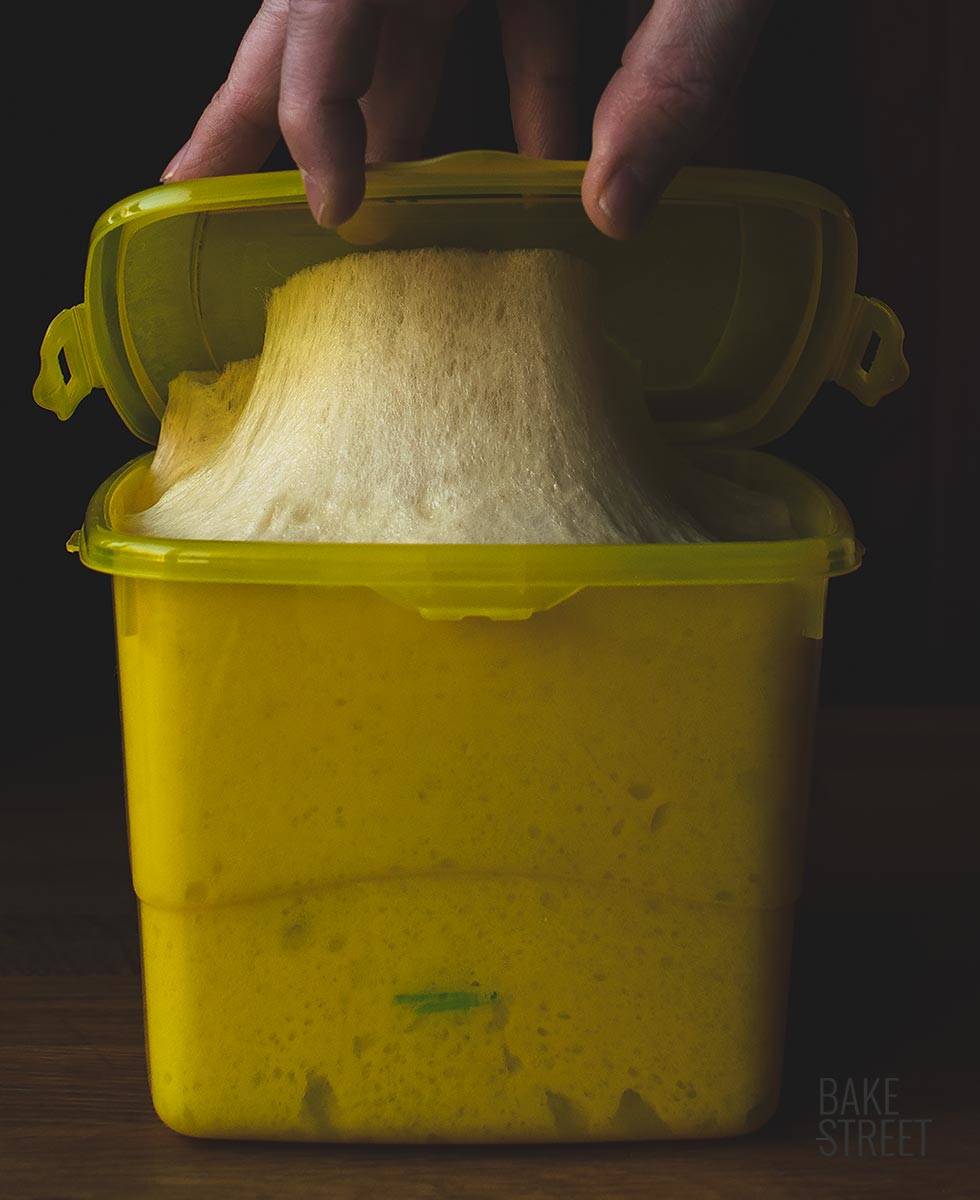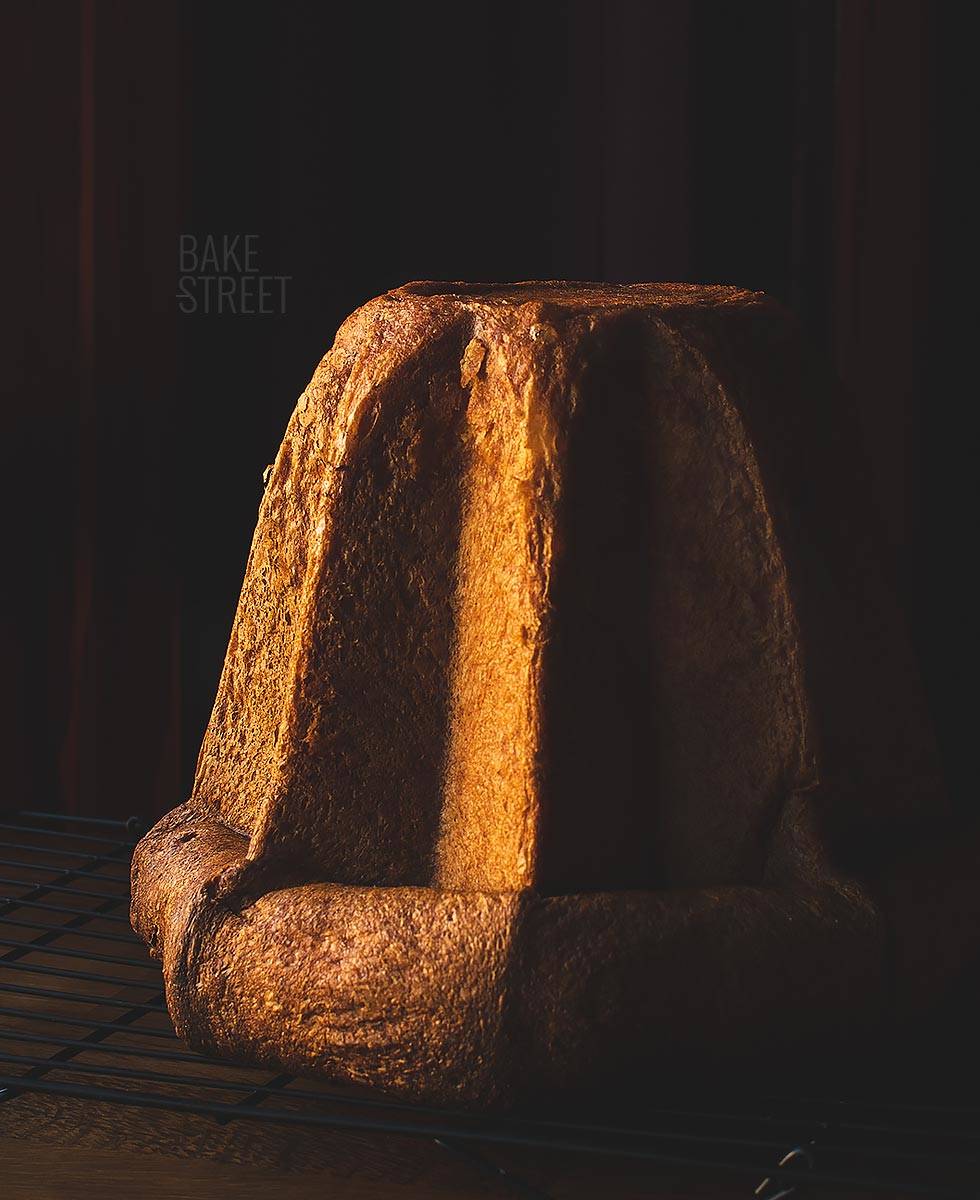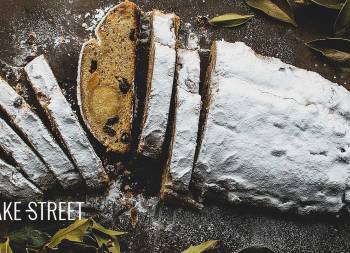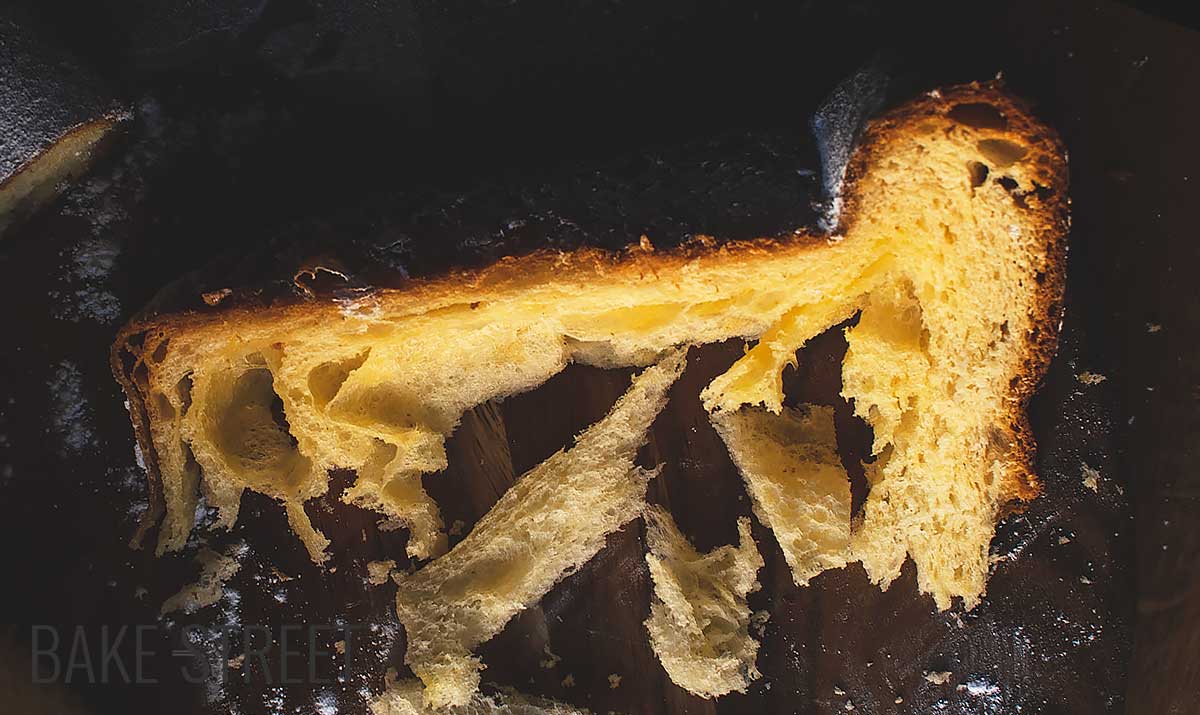
Pandoro made with stiff sourdough
The recipe of this Pandoro made with stiff sourdough has come a little unexpected because it was born thanks to sourdough leftovers that I did not want to discard. I’ll tell you more. As I told you a few days ago, I am sharing in my IG stories the day-to-day process of making a Panettone. And with it, the elaboration of a stiff sourdough. Crazy, I know, but good to see what comes out of all this XD
Every day I make 2 refreshments to my sourdough, which leaves me daily an approximate amount of 350 g of SD that I will not use. The first few days, I did discard it because I considered that it was not yet sufficiently active, predictable and stable to be used in any elaboration. But there came a moment, specifically I think the 9-10 day since its creation, when I wanted to use it. First I made 2 tin loaves that came out great and then I was encouraged to prepare Pandoros.
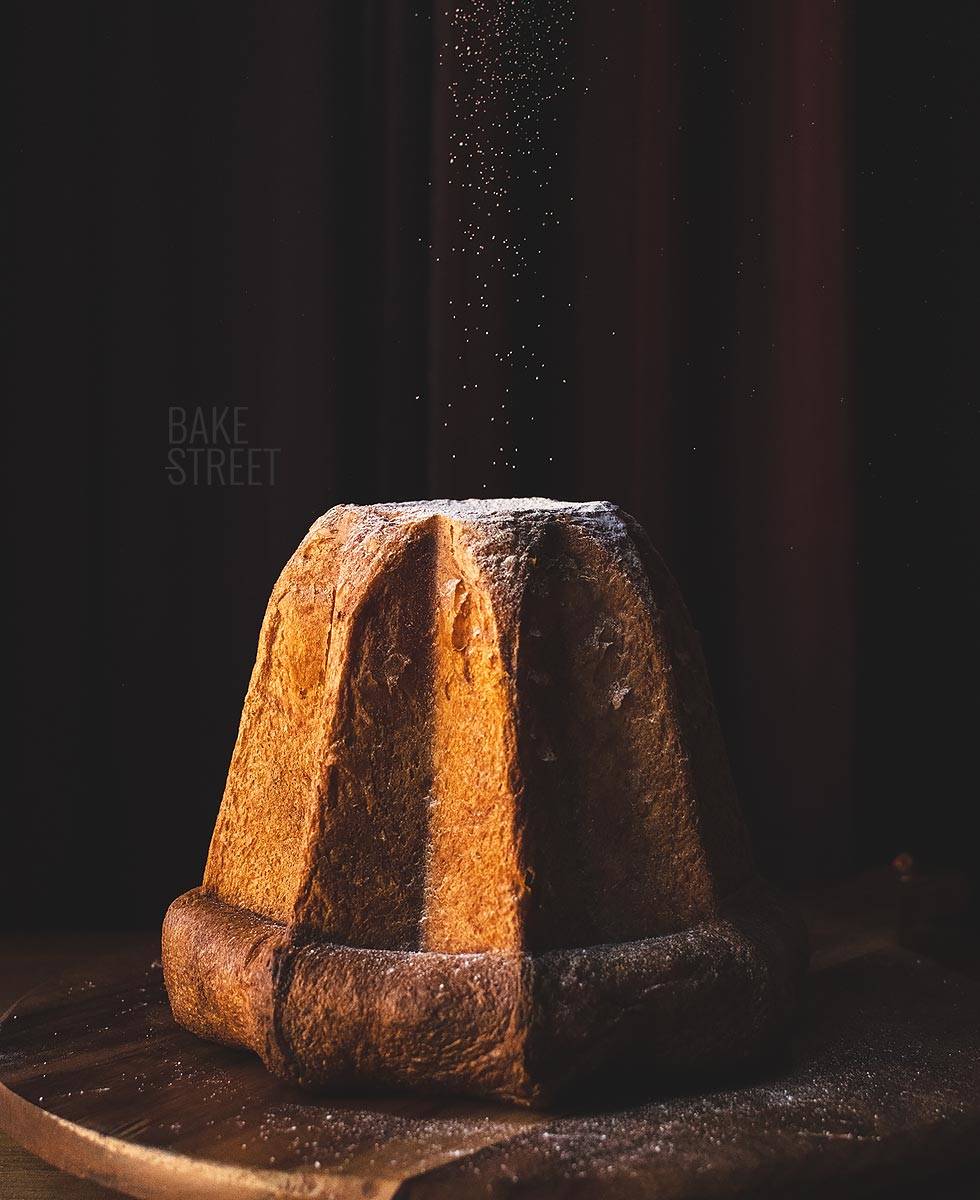
Making a Pandoro with stiff sourdough.
At first I thought about making a Stollen, but it was to see the Pandoro pan and change my mind. The recipe I leave you is based entirely on the recipe I left you last year to make the Pandoro Sfogliato Variegato. To tell you the truth, you are going to find a great similarity between both recipes, changing the type, amount of sourdough and the process of making it. Which is subtly different.
Then you might wonder why I share such a similar recipe and it is because you have asked me a lot during these days. Despite having a certain or great resemblance, some aspects change. So in the end I decided to leave you how to make a Pandoro with a SD hydrated to another proportion and shaping it in the traditional way as shown in the Pandoro, original Simili recipe.
If I don’t have stiff sour dough for panettone, can I do it anyway?
Of course, there’s no major problem.
All you have to do is transform your SD, if it is 100% hydrated, into a stiff format. Also keep in mind that it is very important to make several refresh before using it because we must completely remove the possible acidity it may have.
This step is very important to achieve a good result, both in flavor and aroma, as in the structure of the crumb. I’ll talk to you about this very soon. For me it is turning out to be very interesting and I believe that since I am taking into account many aspects that before I cared less, the results are improving little by little.
An indescribable aroma and taste.
The result is spectacular. Really, and it’s not an exaggeration.
The aroma and flavor is sweet, smooth and wonderful. The crumb is practically like eating a cotton cloud, we can shred it almost in the same way as the panettone. Not the same, the same, but in a very similar way. I am very happy with the results, despite being aware that I must work more on it to improve some aspects.
At the moment I can tell you that these last pandoros are the best that I have prepared at home without a doubt. And much of that improvement is given by the SD, the dough manipulating process, in addition to having controlled at all times the temperature of this. But I will tell you later and little by little because this has a lot of explanation.
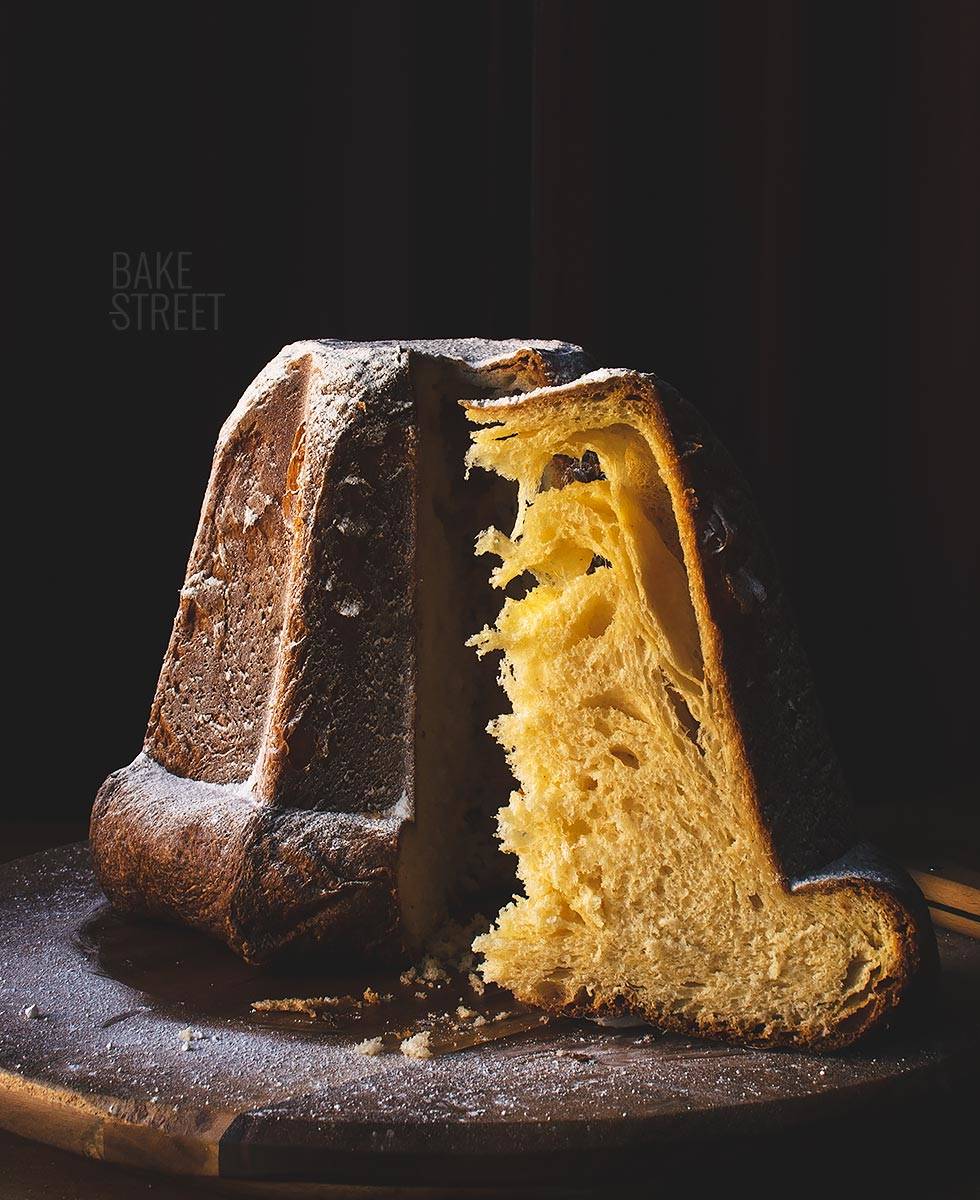
Ingredients
I used a pan with a capacity of 3 litres or 1 kg.
FOR PRIMO IMPASTO:
- 257 g Manitoba flour, w=380-400
- 100 g stiff sourdough, about 50% hydrated
- 77 g sugar
- 165 g egg, about 3 large eggs
- 90 g unsalted butter at room temperature
FOR SECONDO IMPASTO:
- 45 g Manitoba flour, w=380-400
- 45 g yolks, about 2 large yolks
- 38 g sugar
- 26 g cream 35,1% fat
- 4 g salt
FOR EMULSION:
- 56 g unsalted butter at room temperature
- 6 g honey
- 44 g sugar
- 8 g rum
- 1/2 vanilla pod or 2 g natural vanilla extract
FOR THE FOLDING:
- 155 g unsalted butter
Instructions
Make el primo impasto.
- In the bowl of KA or a stand mixer, pour the eggs together with the sugar. Mix with the whisk at a speed of 1 until both ingredients are homogenized.
- Remove the whisk and place the hook. Add the flour together with the sourdough chopped, knead at speed 1 until you get a good development of gluten. It'll take about 15 minutes.
- Once we have a developed gluten, start to integrate the butter. We will do it in batches and wait for the first batch to be integrated before adding more.
- Knead at speed 1 until we obtain a perfect gluten development. The dough will be completely curled on the hook leaving the sides of the bowl clean. It'll take about 25 minutes.
- Remove the dough from the bowl of the kneader, make a ball with care and place it in a clean bowl. Cover with film or put in a large freezer bag.
- Let it rise at room temperature until its volume quadruples. It will take us about 18 hours at a 71,6ºF (22ºC).
- Place the dough in the refrigerator at 39ºF and leave for 1 hour.

Make the emulsion.
- In a bowl mix all the ingredients of the emulsion, set aside.
Make secondo impasto.
- Transfer the primo impasto to the bowl of the kneader directly from the fridge, you will notice that the interior has created a perfect and precious gluten mesh.
- Add the flour and knead until the gluten develops perfectly. The dough will be curled completely on the hook. It will take about 17-18 minutes.
- Pour the yolks into the dough and knead them again until they are completely integrated. It'll take about 5 minutes.
- Add the sugar and continue kneading for 7 more minutes.
- Pour the cream into a thin and continuous thread while the kneader is still working.
- Finally add the salt and continue kneading until we obtain a developed and elastic dough.
Add the emulsion.
- Add the emulsion little by little and wait for it to fully integrate into the dough before adding more.
- Knead until it is fully integrated.
- Once we have integrated everything, we will knead until it is fully integrated. The final kneading temperature must be between 75º-77,8ºF / 25º-26ºC.
- Take the dough out of the bowl, make a ball and place it in a clean bowl. Cover with film or put in a large freezer bag. Set aside.
Refrigerate the dough.
- Place the dough in the refrigerator. We'll leave it until its temperature drops to 46,4ºF (8ºC). To do this we will use a digital thermometer, we will prick the dough to know its internal temperature.
- It will take about 3 1/2 hours.
Prepare the butter.
- Prepare two Teflon sheets and place the butter on one of them. Cover with the other sheet and start tapping it with a rolling pin to flatten it.
- Flatten it to a square shape, or as far as possible, about 5,9 inches (15 cm) on each side. Remember that butter must have a malleable consistency when placed on the dough.
- Set aside.
Make folds.
- Remove one of the dough from the cold and transfer it on a work table lightly sprinkled with flour.
- Stretch with the help of a roller, preferably metallic, and stretch to form a square of about 9,84 inches (25 cm) side.
- Place the butter in the center forming a square. Remember to use it not cold and not at room temperature, see process of Danish dough.
- Fold the corners of the dough stretched over the butter, as if closing an envelope, seal well and proceed to stretch.
- Stretch with the roller shaping a rectangle with a length of approximately 13,7 inches (35 cm).
- Fold the dough as if we were closing a triptych, turn 90º so that the open part of the dough looks towards us, cover with film and let it stand 15 minutes at room temperature.
- Remove the second dough from the fridge, which we have not yet worked, and proceed to make folds in the same way as the first. Let rest for 15 minutes.
- We return with the first dough and stretch again to a length of 15,7 inches (40 cm) .
- Fold again like a triptych, cover with film and let rest another 15 minutes.
We will do this step a total of 3 times. - In the last stretch, let the covered dough stand for 15 minutes at room temperature.
Shape pandoro.
- Grease the Pandoro pan very well with butter, set aside.
- Shape the dough into a ball by inserting the folds inwards. With your hands lightly smeared with butter, carefully bowl and place in the pan with the sealed part facing upwards. Leaving the smooth and "beautiful" side at the base of the pan.
- Cover with film or place in a large freezing bag.
- Let it rise at room temperature until it reaches the edge of the pan. In my case it took 16 hours at 69,8ºF (21ºC).
Bake.
- Once the dough reaches the edge of the pan, place it in the refrigerator at 39,2ºF (4ºC) for 15 minutes.
- Meanwhile, preheat the oven to 340ºF (170ºC).
- After that time, take the Pandoro out of the fridge and transfer it in the oven. Bake for 50 minutes.
- In the middle of baking, cover with an aluminium foil to prevent it from get too brown. The internal temperature must reach 199-201ºF (93-94ºC) for the cooking to be perfect.
- Remove from the oven and leave to cool inside the pan on a rack for 4 hours.
- Remove from the pan and let it cool and dry slightly on the rack. With the widest base resting on the rack.
- Sprinkle with icing sugar and serve.

Notes
- The sourdough we use to make the pandoro must be refreshed several times before using it. We must completely remove the acidity.
- In my case I have used leftovers stiff sourdough that I am making for Panettone. In a short time I will leave you the process so that you can make it.
- The state of SD will condition the rising speed of your Pandoro. In my case the first one I made took 16 hours in the final fermentation, but the second one I made in just 12 hours was ready to bake. This is due to the fact that the SD gets stronger as the days go by.
- We must obtain a perfectly developed gluten at every step. Don't get ahead of yourselves in any case. If your dough takes a little longer to develop gluten, nothing happens.
- The temperature of the dough must always be around a maximum of 77-78,8ºF (25-26ºC). Now in winter it is easier to achieve this, but it would be good if you check the temperature from time to time. In case this increases, stop kneading and refrigerate it for a few minutes.

- It is important that the ingredients are of high quality, because this will always have an impact on the final result.
- The original recipe uses cocoa butter, in my case I didn't have and I replaced it with good quality of butter, you can use good white chocolate.
- The dough must be refrigerated to help maintain an optimal temperature for working with it. In the previous step to puff pastry, we must reduce the temperature to 46,4ºF (8ºC) because it is a dough with a considerable hydration and in order to stretch it we need it to be hard/firm.
- In the folding process it is not necessary to refrigerate the dough after each fold. The cold of the dough itself and the butter, will keep them in perfect condition.
- The ideal temperature for rising this dough is 75-78,8ºF (24-26ºC).
- It is a dough that grows a lot during the baking process. In my case, placing it in the final position starting from the bottom.
- Preservation: Once it is completely cold, put in a large bag with zipper clip and hold us for several days. I recommend you sprinkle the icing sugar just before serving.

If you like Pandoro, you can't stop trying it with a stiff sourdough. If there is one thing that allows us to learn and improve, it is to try the same recipe carrying it out in different ways. Don't be afraid to experiment, what is the worst that can happen? What goes wrong? Surely the taste will be good and the process will allow us to learn and move forward.
Never be afraid to change a recipe. If you know well your dough, sourdough, ingredients ... besides the process you are going to do, there is nothing to fear. Only good things can come out of that and, as I said otherwise, it will also leave us something good that will be learning.
I wish you a wonderful beginning of the week!
Big hugs,
Eva
